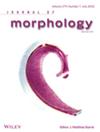下载PDF
{"title":"The periesophageal celom of the articulate brachiopod Hemithyris psittacea (Rhynchonelliformea, Brachiopoda)","authors":"Tatyana V. Kuzmina, Vladimir V. Malakhov","doi":"10.1002/jmor.10904","DOIUrl":null,"url":null,"abstract":"<p>The celomic system of the articulate brachiopod <i>Hemithyris psittacea</i> is composed of the perivisceral cavity, the canal system of the lophophore, and the periesophageal celom. We study the microscopic anatomy and ultrastructure of the periesophageal celom using scanning and transmission electron microscopy. The periesophageal celom surrounds the esophagus, is isolated from the perivisceral cavity, and is divided by septa. The lining of the periesophageal celom includes two types of cells, epithelial cells and myoepithelial cells, both are monociliary. Some epithelial cells have long processes extending along the basal lamina, suggesting that these cells might function as podocytes. The myoepithelial cells have basal myofilaments and may be overlapped by the apical processes of the adjacent epithelial cells. The periesophageal celom forms protrusions that penetrate the extracellular matrix (ECM) of the body wall above the mouth and the ECM that surrounds the esophagus. The canals of the esophageal ECM form a complicated system. The celomic lining of the external circumferential canals consists of the epithelial cells and the podocyte-like cells. The deepest canals lack a lumen; they are filled with the muscle cells surrounded by basal lamina. These branched canals might perform dual functions. First, they increase the surface area and might therefore facilitate ultrafiltration through the podocyte-like cells. Second, the deepest canals form the thickened muscle wall of the esophagus and could be necessary for antiperistalsis of the gut. J. Morphol., 2011. © 2010 Wiley-Liss, Inc.</p>","PeriodicalId":16528,"journal":{"name":"Journal of Morphology","volume":"272 2","pages":"180-190"},"PeriodicalIF":1.5000,"publicationDate":"2010-12-01","publicationTypes":"Journal Article","fieldsOfStudy":null,"isOpenAccess":false,"openAccessPdf":"https://sci-hub-pdf.com/10.1002/jmor.10904","citationCount":"11","resultStr":null,"platform":"Semanticscholar","paperid":null,"PeriodicalName":"Journal of Morphology","FirstCategoryId":"3","ListUrlMain":"https://onlinelibrary.wiley.com/doi/10.1002/jmor.10904","RegionNum":4,"RegionCategory":"医学","ArticlePicture":[],"TitleCN":null,"AbstractTextCN":null,"PMCID":null,"EPubDate":"","PubModel":"","JCR":"Q2","JCRName":"ANATOMY & MORPHOLOGY","Score":null,"Total":0}
引用次数: 11
引用
批量引用
Abstract
The celomic system of the articulate brachiopod Hemithyris psittacea is composed of the perivisceral cavity, the canal system of the lophophore, and the periesophageal celom. We study the microscopic anatomy and ultrastructure of the periesophageal celom using scanning and transmission electron microscopy. The periesophageal celom surrounds the esophagus, is isolated from the perivisceral cavity, and is divided by septa. The lining of the periesophageal celom includes two types of cells, epithelial cells and myoepithelial cells, both are monociliary. Some epithelial cells have long processes extending along the basal lamina, suggesting that these cells might function as podocytes. The myoepithelial cells have basal myofilaments and may be overlapped by the apical processes of the adjacent epithelial cells. The periesophageal celom forms protrusions that penetrate the extracellular matrix (ECM) of the body wall above the mouth and the ECM that surrounds the esophagus. The canals of the esophageal ECM form a complicated system. The celomic lining of the external circumferential canals consists of the epithelial cells and the podocyte-like cells. The deepest canals lack a lumen; they are filled with the muscle cells surrounded by basal lamina. These branched canals might perform dual functions. First, they increase the surface area and might therefore facilitate ultrafiltration through the podocyte-like cells. Second, the deepest canals form the thickened muscle wall of the esophagus and could be necessary for antiperistalsis of the gut. J. Morphol., 2011. © 2010 Wiley-Liss, Inc.
腕足动物(腕足目,舌足目)的食道周围细胞
腕足动物的经济系统由内脏周围腔、食管管系统和食管周围腔组成。我们采用扫描电镜和透射电镜对食管周围纤维的显微解剖和超微结构进行了研究。食管周围纤维环绕食道,与内脏周围腔分离,由隔隔分隔。食管周围纤维的内膜包括两种类型的细胞,上皮细胞和肌上皮细胞,均为单纤毛细胞。一些上皮细胞具有沿基板延伸的长突,提示这些细胞可能具有足细胞的功能。肌上皮细胞具有基底肌丝,可能与相邻上皮细胞的顶端突起重叠。食道周围纤维形成突出物,穿透口腔上方体壁的细胞外基质和包围食道的细胞外基质。食管ECM的管道形成了一个复杂的系统。外周管的经济衬里由上皮细胞和足细胞样细胞组成。最深的运河没有管腔;它们充满了被基底层包围的肌肉细胞。这些分支管可能具有双重功能。首先,它们增加了表面积,因此可能促进通过足细胞样细胞的超滤。其次,最深的管道形成增厚的食道肌壁,可能是肠道反蠕动所必需的。j . Morphol。, 2011年。©2010 Wiley-Liss, Inc
本文章由计算机程序翻译,如有差异,请以英文原文为准。


